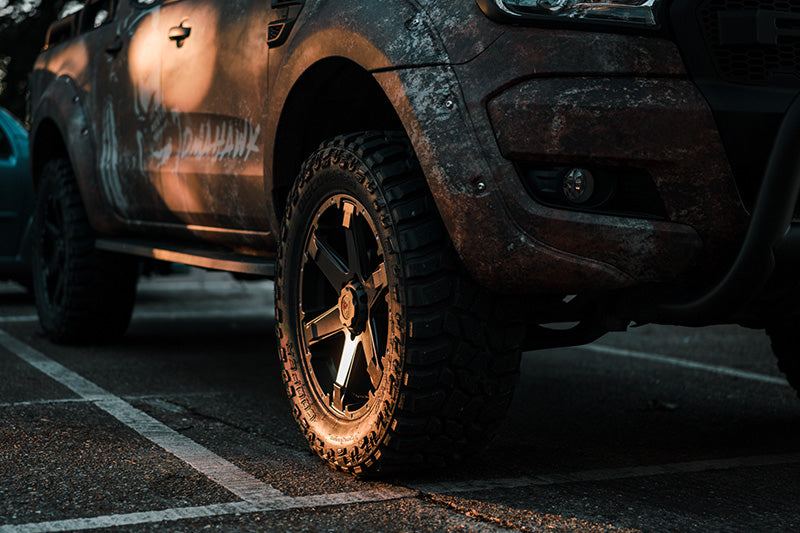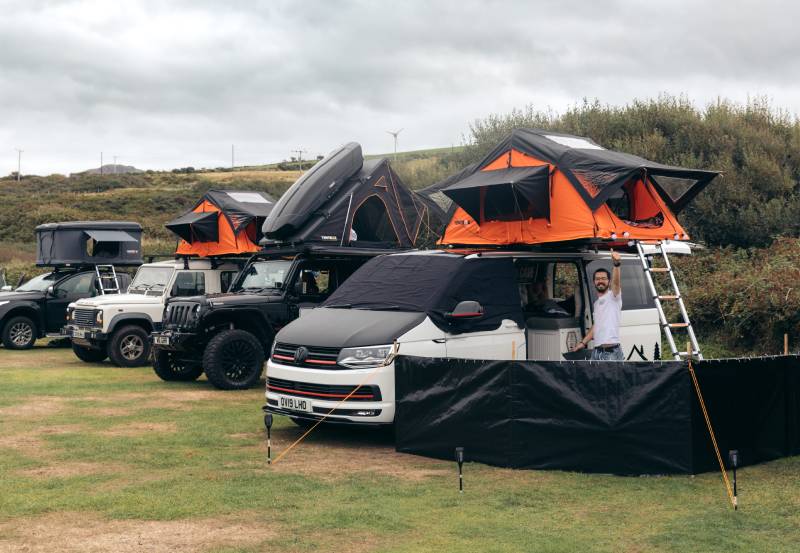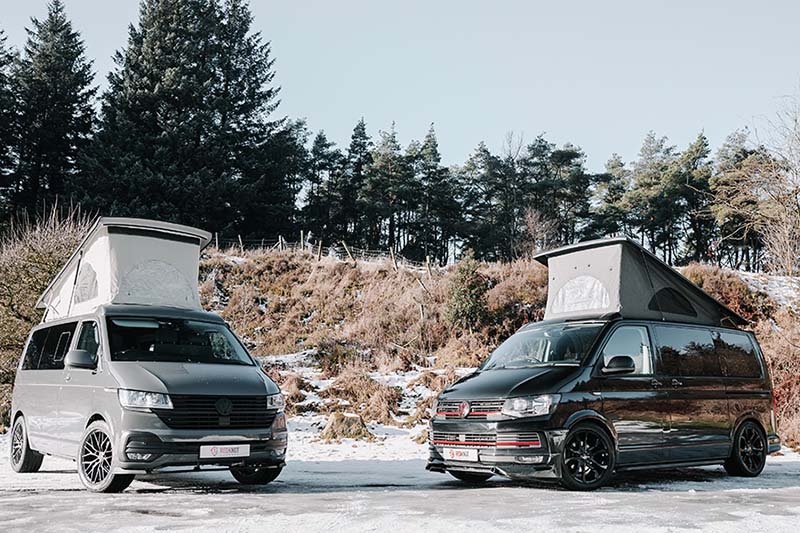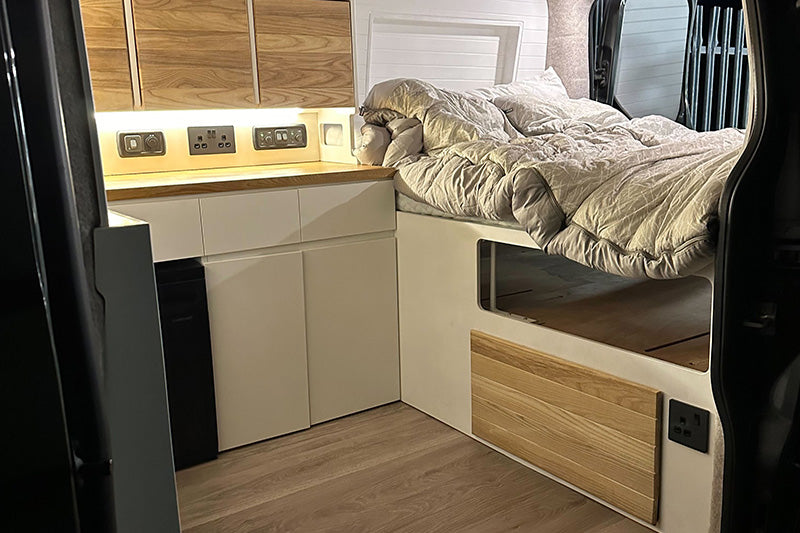The Swamper Style Wheels & Tyres Guide

The swamper campervan! You’ve definitely seen one. That van that looks like it was converted in a lab rather than a workshop and is specced out as if it might need to do a stint in the military. Well today we’re going to look at one crucial aspect of the classic swamper campervan look. The wheels and tyres.
As you gear up for off-road adventures, prepare for the zombie apocalypse, or just want to make a bit more of a statement with your beloved van, here are some essential considerations to keep in mind – a roadmap, if you will, for a swamper wheel and tyre setup the drives as well as it looks.
But before we jump in, let’s cover off a wheel and tyre 101, so we’re all clear on what to consider when buying a wheel and what all those letters and numbers mean on the wall of your rubber. This is foundational to de-mystifying your swamper setup.
Swamper Wheels - Style, Size & Fit

So let’s start with the wheels. A new set of wheels is probably the single most impactful style change you can make to the exterior of a campervan and If you’re going after that swamper look, then it’s important to choose wisely. Choosing the right wheels for your campervan is a crucial decision that can greatly impact your overall driving experience, especially if you're into the swamper style. So let’s look at the key things you really need to consider.
- Wheel Size: Swamper style vans often look more rugged and off-road-ready with larger wheels (and large tyres). However, consider the balance between aesthetics and functionality. Larger wheels might affect fuel efficiency and ride comfort (more on that later), and your van may also need raising to accommodate a large wheel and tyre combination. So sometimes it makes more sense to go for a smaller wheel to make sure you have room for a good all-terrain tyre.
- Load Rating: Ensure that the chosen wheels can handle the weight of your fully loaded campervan. Consider not only the vehicle's weight but also the additional load from equipment, water tanks, and personal belongings. All wheels usually show a max load rating limit per wheel, so ensure that the 4 wheels add up to a total that is greater than the weight of your campervan.
- Offset and Backspacing: Another key consideration when buying wheels is Wheel offset, which is typically expressed as a numerical value in millimetres. This number signifies the distance between the wheel's mounting surface and the wheel centerline. A positive offset means the mounting surface is towards the outside of the wheel. This setup tends to tuck the wheels closer to the vehicle's body, promoting a more stable and tucked-in appearance. Conversely, a negative offset places the mounting surface towards the inside of the wheel. This pushes the wheels outward, giving your camper van a broader stance. Negative offset is often associated with a more aggressive, wider look.
- Lug/Bolt Pattern: Match the lug pattern of the wheels with that of your campervan. This ensures a secure fit. Most campervans have a 5-lug pattern, but it's always good to double-check.
Remember, the right wheels not only enhance the appearance of your campervan but also contribute to its functionality, especially in off-road/swamper scenarios. Take your time, do your research, and make a choice that aligns with your driving preferences and the kind of adventures you're planning.
Swamper Tyres - Decoding the Size Magic

Now let's look at Tyres. The first thing to understand when sizing up tyres for your dream swamper look, is the string of numbers and letters on the tyre wall that look like they belong on a physics whiteboard. This is the sizing information and technical specification for the tyre. An example would be 255/45R18 103T. So let’s break down what the different elements of that number mean
Width (Millimetres): The first number represents the tyre's width in millimetres. It's the measurement from one sidewall to the other when the tyre is properly inflated, and it's crucial for maintaining stability on the road.
Aspect Ratio (%): The second number is the aspect ratio, expressing the height of the tyre sidewall as a percentage of the tyre's width. A lower aspect ratio means a lower-profile tyre, often associated with better handling.
Construction Type: The letter that follows indicates the tyre's construction type. For example, "R" stands for radial construction, the most common type in modern vehicles.
Wheel Diameter (Inches): The final number represents the diameter of the wheel the tyre is designed to fit, measured in inches. It's like the tyre's way of saying, "I belong on this size wheel."
Load rating (Inches): Load ratings are indicated by a numerical code on the tyre sidewall. This load index corresponds to a specific weight-carrying capacity. As an example, a common load index for VW Transporter tyres might be around 103 to 109. To give you a rough idea, a load index of 103 is good for 875 kilograms, and a 109 carries 1,030 kilograms per tyre. Just like with wheels, multiply the rating by 4 and this gives you a total, which should exceed the weight of your van.
Speed Rating: Speed Ratings are indicated by a letter code:
- T: Up to 118 mph
- U: Up to 124 mph
- H: Up to 130 mph
- V: Up to 149 mph
These are general values, and it's crucial to refer to your specific vehicle's manual or the information provided on the tire sidewall for precise details.
Putting it All Together
Now, let's put it all together with the following example tyre size: 255/45R18 103T
- 255: The tyre is 255 millimetres wide from sidewall to sidewall.
- 45: The aspect ratio is 45%, indicating that the height of the sidewall is 45% of the tyre's width.
- R: Radial construction for a smoother ride and better grip.
- 18: The tyre is designed to fit a 18-inch wheel.
- 103T: The tyre is rated to a load rating of 875 kilograms per tyre and has a speed rating of up to 118 mph
What does all this mean for your Swamper Van?
So now that we understand the wheel considerations and you're able to read a tyre size like a pro, let's look at some specific considerations that you need to keep in mind when speccing your perfect Swamper setup
The Size Dilemma: Striking the Perfect Balance
Embarking on the Swamper journey means confronting the age-old question – how big is too big? While larger wheels might scream off-road prowess, consider the impact on your camper's handling and fuel efficiency. Find that sweet spot where performance meets practicality, ensuring a ride that's both exciting and efficient.
A lower aspect ratio often means better cornering ability due to less sidewall flex. Consider your driving style and the terrain you'll tackle. A wider tyre can enhance stability, especially during cornering, but it might affect fuel efficiency.
Altitude and attitude: Lifted or lowered suspension
In general a Swamper Tyre set up on a T5/T6 VW Transporter for example will add nearly 5cm to the overall diameter of the wheel. From a style perspective, this really fills the arch nicely compared to the stock panel van look, but it also uses up wheel arch space.
In general, we would say swamper tyres are for running on standard springs or ride height or with a lift kit. If you are on comfort springs, in the region of 35mm drop, you may be ok, but wheel offset and tyre width will affect the clearance you have from the tyre to the wheel arch.
As a rule, coilovers are a no no and a safe stance is a stock stance or higher.
Weighing In: Ensuring Your Camper Can Carry the Load
Swamper wheels and tyres can be hefty additions to your camper. Before committing, check if your van can handle the extra weight. We want your camper to be a nimble explorer, not a sluggish adventurer weighed down by excess baggage.
Tread Patterns: Matching Terrain to Traction
Picture your tyres as the shoes for your camper – you wouldn't wear flip-flops to a rock concert, would you? Swamper tyres come in various tread patterns, each designed for specific off-road conditions. Whether it's mud, rocks, or sand, choose a pattern that complements your off-road ambitions.
Of course, choosing off-road tyres doesn’t mean you want to drive ‘off-road’. So if it’s a choice for the sake of styling, consider these potential compromises:
Road Noise:
- Swamper tyres typically have a more aggressive tread pattern with large, deep lugs and open voids. This design can result in increased road noise compared to standard all-season or highway-terrain tyres.
- The large, open tread blocks on swamper tyres can create a louder and more noticeable hum or rumble while driving on smooth and paved surfaces.
- If minimising road noise is a priority for your driving experience, swamper tyres may not be the best choice.
Fuel Economy:
- Swamper tyres can also have an impact on fuel economy. The aggressive tread pattern and larger, more rigid construction can increase rolling resistance, which is the force resisting the tyre's movement.
- Higher rolling resistance requires more energy to keep the tyres moving, potentially leading to a decrease in fuel efficiency.
- If fuel economy is a significant concern, it's advisable to consider that swamper tyres might not be as fuel-efficient as highway-terrain or all-season tyres.
It's important to note that the extent of these effects can vary depending on the specific tyre design, brand, and size. Advancements in tyre technology may also mitigate some of these issues in newer models. Additionally, proper tyre maintenance, including regular inflation checks and rotations, can help optimise performance and fuel efficiency.
A common alternative to the swamper is the standard tyre tread pattern, but with a larger Aspect Ratio, if we use the earlier example of a 255/45R18, then scale this up to a 50% aspect ratio and use a 255/50R18, this gives an increased overall wall size so fills the wheel arch better, but without the compromises on road noise and fuel economy.
Speed Ratings: Setting Realistic Expectations
While Swamper tyres excel off-road, they might not boast the same speed ratings as their highway counterparts. Embrace a more leisurely pace on your off-road escapades. After all, it's about savouring the journey, not setting land-speed records.
Alignment Aikido: Finding the Zen of Balance
Installing Swamper wheels can throw your camper's balance off-kilter. After changing the size or stance of your Camper, always schedule a professional alignment to ensure a smooth ride. Picture your camper as a master of alignment Aikido, gracefully navigating the twists and turns of the off-road realm.
Spare tyre Ballet: Don't Leave It on the Sidelines
In the excitement of new Swamper wheels, don't neglect the spare tyre. Ensure it's ready for a performance when called upon. A flat tyre shouldn't be the finale of your off-road symphony.
Fuel Efficiency Chronicles: Balancing Thirst and Thrills
Be aware that Swamper tyres might have a thirst for fuel. Keep a watchful eye on your mileage, and consider bringing along extra fuel for those remote adventures. We're all for the thrill of the journey, but running out of gas in the wilderness is a plot twist best avoided.
Conclusion
Before choosing a swamper wheel and tyre setup, it's essential to consider your driving needs and preferences. If off-road capability is a top priority and you don't mind the potential increase in road noise and decrease in fuel efficiency, swamper tyres might be a suitable choice. However, if you primarily drive on paved roads and prioritise comfort and fuel economy, you may want to explore other options.
As you embark on your Swamper expedition, remember that every decision is a step toward a more adventurous and capable camper van. May your off-road escapades be filled with excitement, and your Swamper wheels carry you to new horizons with both style and reliability. If you want to talk through a potential wheel and tyre setup for your campervan, then speak to the team at Redknot Campers and we'll be happy to advise.





